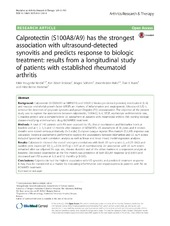| dc.contributor.author | Nordal, Hilde Haugedal | en_US |
| dc.contributor.author | Brokstad, Karl Albert | en_US |
| dc.contributor.author | Solheim, Magne | en_US |
| dc.contributor.author | Halse, Anne-Kristine | en_US |
| dc.contributor.author | Kvien, Tore Kristian | en_US |
| dc.contributor.author | Hammer, Hilde Berner | en_US |
| dc.date.accessioned | 2017-08-15T10:53:43Z | |
| dc.date.available | 2017-08-15T10:53:43Z | |
| dc.date.issued | 2017-01-12 | |
| dc.Published | Nordal HH, Brokstad KA, Solheim M, Halse AK, Kvien TK, Hammer Hb. Calprotectin (S100A8/A9) has the strongest association with ultrasound-detected synovitis and predicts response to biologic treatment: results from a longitudinal study of patients with established rheumatoid arthritis. Arthritis Research & Therapy. 2017;19(3):1-10 | eng |
| dc.identifier.issn | 1478-6362 | |
| dc.identifier.uri | https://hdl.handle.net/1956/16279 | |
| dc.description.abstract | Background: Calprotectin (S100A8/A9 or MRP8/14) and S100A12 (leukocyte-derived proteins), interleukin 6 (IL-6) and vascular endothelial growth factor (VEGF) are markers of inflammation and angiogenesis. Ultrasound (US) is sensitive for detection of greyscale synovitis and power Doppler (PD) vascularization. The objective of the present study was to explore the associations between calprotectin, S100A12, IL-6, VEGF, erythrocyte sedimentation rate, C-reactive protein and a comprehensive US assessment in patients with rheumatoid arthritis (RA) starting biologic disease-modifying anti-rheumatic drug (bDMARD) treatment. Methods: A total of 141 patients with RA were assessed by US, clinical examination and biomarker levels at baseline and at 1, 2, 3, 6 and 12 months after initiation of bDMARDs. US assessment of 36 joints and 4 tendon sheaths were scored semi-quantitatively (0–3 scale). European League Against Rheumatism (EULAR) response was calculated. Statistical assessments performed to explore the associations between biomarkers and US sum scores included Spearman’s rank correlation analysis as well as linear and linear mixed model regression analyses. Results: Calprotectin showed the overall strongest correlations with both US sum scores (r s = 0.25–0.62) and swollen joint counts (of 32) (r s = 0.24–0.47) (p < 0.05 at all examinations). An association with US sum scores remained after we adjusted for age, sex, disease duration and all the other markers in a regression analysis at baseline. Decreased calprotectin at the first month was predictive of both EULAR response (p ≤ 0.001) and decreased sum PD scores at 3, 6 and 12 months (p ≤ 0.05). Conclusions: Calprotectin had the highest association with US synovitis and predicted treatment response. It may thus be considered as a marker for evaluating inflammation and responsiveness in patients with RA on bDMARD treatment. | en_US |
| dc.language.iso | eng | eng |
| dc.publisher | BioMed Central | eng |
| dc.rights | Attribution CC BY | eng |
| dc.rights.uri | http://creativecommons.org/licenses/by/4.0 | eng |
| dc.subject | Rheumatoid arthritis | eng |
| dc.subject | Biomarkers | eng |
| dc.subject | Calprotectin | eng |
| dc.subject | S100A12 | eng |
| dc.subject | Interleukin 6 | eng |
| dc.subject | Vascular endothelial growth factor | eng |
| dc.subject | Ultrasound | eng |
| dc.title | Calprotectin (S100A8/A9) has the strongest association with ultrasound-detected synovitis and predicts response to biologic treatment: results from a longitudinal study of patients with established rheumatoid arthritis | en_US |
| dc.type | Peer reviewed | |
| dc.type | Journal article | |
| dc.date.updated | 2017-08-09T20:04:29Z | |
| dc.description.version | publishedVersion | en_US |
| dc.rights.holder | Copyright 2016 The Author(s) | |
| dc.identifier.doi | https://doi.org/10.1186/s13075-016-1201-0 | |
| dc.identifier.cristin | 1426741 | |
| dc.source.journal | Arthritis Research & Therapy | |

